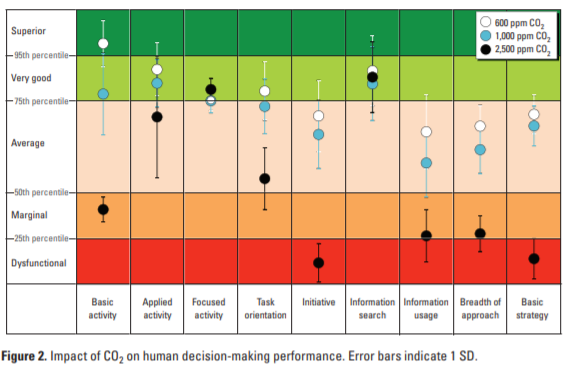How CO2 threatens well-being, productivity and health at office work
Everyone has experienced burning eyes and dry throats while working at an office or at home. Or even at daily basis. In our heavy-isolated offices, good ventilation is not always paramount. This causes high levels of CO2. It evokes nuisance, long term exposure can cause fatigue, headaches and dizziness. It lessens your productivity and general feeling of well-being. And it may even help to develop lung inflammation, hypercapnia acidosis and suppressing of the immune system. That’s why ventilation is important. Sensors can help to measure CO2.
The importance of healthy CO2 levels
Where there has been a time that the CO2 level is seen as an indication for ventilation, nowadays CO2 is seen as a pollutant itself.
CO2 (Carbon Dioxide) occurs naturally. Before the industrial area, the concentration level was about 280 Parts Per Million (PPM). Since then, the level has increased to 0.04% (412 PPM).
It is important that the CO2 concentration remains less than 800 PPM. If concentrations get higher, humans are beginning to suffer. And CO2 levels rise mostly unmarked, as people are concentrated on their work. CO2 levels rise fast, but also too gradually to register immediately. You may not even recognize you’re not feeling unwell, until you get outside or feel really uncomfortable already. Probably you have experienced being in a ‘sick building’ yourself. When 1 person enters a room of about 4 m2, the level of CO2 may increase from 500 PPM (healthy) to over 1000 PPM (affects your well-being) in just 45 minutes.
High CO2 levels affect the feeling of well-being
From 800 PPM, people may begin to suffer. When the PPM stays low enough, this suffering is only temporary and disappears when people breath in fresh air, for instance dry eyes or throats. However, this feeling may feel uncomfortable and thus affects your sense of well-being, pleasure in work, etc.
Common complaints of high CO2 levels are:
- discomfort (e.g. odor nuisance and cold/heat complaints)
- headaches (increasing during the day)
- fatigue (increasing during the day)
- drowsiness (increasing during the day)
- ‘sick building’ complaints’ (e.g. ‘dry air’ complaints, mucous membrane irritations)
- worsening of allergies (e.g. hay fever and food allergies)
- transmission of infectious diseases (leading to colds, flu, etc.)
- (additional) asthma attacks in children and teachers with asthma
The impact on productivity of CO2
Research shows that CO2 levels have impact on concentration.:
“For seven of the nine cognitive function domains, average cognitive scores decreased at each higher level of CO2 … Cognitive function scores were 15% lower for the moderate CO2 day (~ 945 ppm) and 50% lower on the day with CO2 concentrations of ~1,400 ppm than on the two Green+ days
(Retrieved from: “Is CO2 an Indoor Pollutant? Direct Effects of Low-to-Moderate CO2 Concentrations on Human Decision-Making Performance “, Usha Satish et al, Environmental Health Perspectives • volume 120 | number 12 | December 2012)
800PPM as absolute miniumum, CO2 levels of 950PPM are common
A level of 800ppm is considered healthy. However, research shows that a level of 950ppm is common.
A 400-PPM increase in CO2 leads to 21% decrease of cognitive scores
“On average, a 400-ppm increase in CO2 was associated with a 21% decrease in a typical participant’s cognitive scores across all domains after adjusting for participant (data not shown), a 20-cfm increase in outdoor air per person was associated with an 18% increase in these scores, and a 500-μg/m3 increase in TVOCs was associated with a 13% decrease in these scores.”
better
green vs
conventional
better
green+ vs
conventional
Another study shows that, combined with TVOC, the impact of high CO2 is even larger: “On average, cognitive scores were 61% higher on the Green building day and 101% higher on the two Green+ building days than on the Conventional building day. The largest effects were seen for Crisis Response, Information Usage, and Strategy, all of which are indicators of higher-level cognitive function and decision making (Streufert and Swezey 1986). For Crisis Response, scores were 97% higher during the Green condition than during the Conventional condition, and 131% higher during the Green+ condition than during the Conventional condition. For Information Usage, scores obtained under the Green and Green+ conditions were 172% and 299% higher than under the Conventional condition, respectively. Finally, for Strategy, which tested the participants’ ability to plan, prioritize, and sequence actions, the Green and Green+ day scores were 183% and 288% higher than on the Conventional day, respectively ”
Because CO2 is odorless and colorless, proper sensors are needed to help ensure the safety of personnel.
Find out how ASN Airmex can help you.





